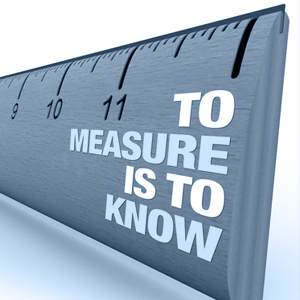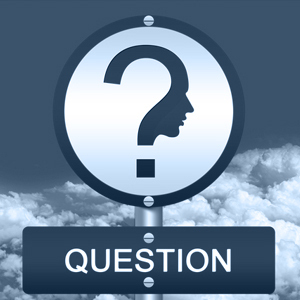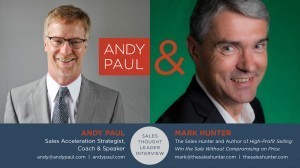Andy Paul's Blog, page 104
January 14, 2015
Do You Stop Selling Too Soon?
Are you ignoring the most important sales call of your sales cycle?
Salespeople routinely dig a hole, and throw themselves in it, after they close an order with a customer. Here’s how it plays out. You receive an order from a new customer, ACME Technologies, and your instinct is to quickly move on to the next prospect before Larry, your new customer at ACME, calls and asks a question that you are afraid of answering out of fear that it will cause him to change his mind.
Do You Stop Selling Too Soon?
The problem here is that even though you have an order, you haven’t finished the job of selling the customer. Your selling process doesn’t stop when you receive an order. There is one more very important step to take. One that can make the difference between having a “one-and-done” customer and a long-term relationship with a loyal, profitable customer.
Watch my video to learn about the most important sales call you should make.
The post Do You Stop Selling Too Soon? appeared first on Andy Paul | Strategies to Power Growth.

January 13, 2015
If You Want To Sell More; Sell Faster
 The logic is unassailable. If you want to sell more, sell faster.
The logic is unassailable. If you want to sell more, sell faster.
As you might expect, I read a lot about sales. And very few sales thought leaders write about the importance of speed in selling. I find this to be more than a bit mystifying because this is exactly what your customers want. Increasingly they want to be able to more quickly gather the information they need to make fully informed purchase decisions with the least investment of their time possible. (If this weren’t true, why are your customers all using the Internet as their default method of investigating and researching new products?)
A study by the research firm IDC found that IT buyers want to chop the length of their buying process by 30% or more. Why? The better question to ask is ‘Why not?’ Think of all the other profitable ways a customer could invest their time if they could compress their evaluation and purchase cycles by 30%.
Helping your prospects to make faster, favorable decisions is a source of tangible value to them. This is not hand waving value of the kind that salespeople typically claim to provide. This is quantifiable, take-it-to-the-bank value for the customer that can be expressed in dollars and cents.
Selling faster doesn’t mean to cut corners. In fact, just the opposite is true. In order to sell faster, you have to be more disciplined in your approach to qualification, discovery, and all of your core sales processes. And you have to be more rigorous and disciplined in using metrics to manage, fine-tune and and accelerate your processes.
Chipotle is a company in the business of selling burritos. And they understand that their ability to increase their sales is not solely limited by how many people they attract to their doors. They have found that they can generate increased sales based on how quickly they help their customers make their decision, pay for their order and send them on their way to eat their food. They are defying the knee-jerk assumption that doing something faster will necessarily result in a degraded customer experience. In fact, they have learned that shrinking the amount of time that their customers have to spend with them is a way to increase satisfaction and build repeat business.
Which is just what your customers hope you will do for them. They don’t want to spend time with you. It’s nothing personal. They just have many other things that they need to do and spending time with a salesperson stands in their way of accomplishing them. Salespeople have a tendency to think that they need to maximize the amount of face time they have with a customer in order to increase their share of mind with the decision-maker. In fact, the opposite is often true. The way you maximize your share of mind with the customer is to have them identify you as the resource that can help them make great decisions faster.
Here are 3 simple steps you can take right now to sell faster:
1. Follow up everything immediately.
If you get a sales lead, an inquiry from a prospect or a question from an existing customer, follow up immediately. Every minute that you delay in following up works against you. You never want to keep a prospect waiting for you. That means that you are wasting their time.
Create metrics that set expectations for your follow up. How long should it take to respond to a lead? How long should it require to respond to a customer question?
2. Be 100% responsive
It is not enough just to follow up quickly. You also have to provide the answer or information that the prospect needs. And you need to provide it in one call, one email or one voice mail. Making prospects wait while you dribble information out to them slows down their decision-making. A quick follow up that is without content is a waste of the customer’s time.
You have to train your prospects to expect to receive something of value from you each time you communicate with them. Scrutinize every potential sales interaction to ensure that it meets that standard for responsiveness.
3. Make a plan for every sales interaction
Selling is about preparation. Not improvisation. Every sales touch, no matter how big or small, needs a plan so that you know exactly how you are going to utilize the customer’s time to deliver value to them. What value, in terms of information or insights, are you going to provide in that touch that will move the customer at least one step forward in their buying process?
Look at every planned sales interaction from the perspective of the buyer and ask yourself if it will meet their goals and give them the incentive to take the next steps toward making their decision with you.
// ]]>
The post If You Want To Sell More; Sell Faster appeared first on Andy Paul | Strategies to Power Growth.

January 12, 2015
Three Rules to Develop Effective Sales Metrics
 It is accepted wisdom that you can’t improve what you don’t measure. This applies equally in life as in sales. You can’t improve your cholesterol levels without drawing some blood. You can’t know how much weight you’ve lost, or gained, without standing on a scale. And, in sales, you can’t improve your performance or productivity without measuring the effectiveness of your sales processes.
It is accepted wisdom that you can’t improve what you don’t measure. This applies equally in life as in sales. You can’t improve your cholesterol levels without drawing some blood. You can’t know how much weight you’ve lost, or gained, without standing on a scale. And, in sales, you can’t improve your performance or productivity without measuring the effectiveness of your sales processes.
This means you need metrics that help you truly understand how you’re doing at any one point in time. But the key is that your metrics should measure the robustness of your sales process, instead of focusing on outcomes.
Here are 3 rules to help you develop more effective metrics.
Focus on Your Process Instead of Outcomes.
Orders are not a metric or a key performance indicator. It is important to remember that orders are just an outcome of a process. In this case, your sales process. Focusing on orders doesn’t tell you enough about the effectiveness of your process, about the value of the series of events that lead up to the outcome and what you could do to improve your process to improve the speed or quantity of outcomes. Orders tell you in a macro sense that your sales process is or isn’t working but they don’t give you the “why.”
Measure Quality Instead of Quantity
Don’t become seduced by the quantity of things as indicators of performance. It’s easy to get distracted by:
How many cold calls did we make?
How many leads did we generate?
How many prospects are in the pipeline?
Instead it is more important to examine your processes from a quality perspective. Ask these questions:
How many conversations did our cold calls generate?
How many leads did we generate that converted into qualified prospects?
How many qualified prospects converted into orders?
Identify the measurable elements of your sales process and define quality based metrics for these that you can measure on an ongoing basis.
Measure Time Rather than Duration.
Every time I work with a company I ask the question: how long is your sales cycle? Invariably, the answers I receive are measured as a period of time: years, months, weeks and days. But, the duration of your sales cycle tells you very little of value about the effectiveness of your selling process. To accurately measure the productivity of a sales rep you have to track how many hours and minutes of sales time he or she invests to move a prospect from Point A (interest) to Point B (decision.)
Time is important on two levels.
First, a sales rep’s time is a fixed sales resource. Therefore, the only reliable way to increase their productivity is to help them decrease the amount of time (versus duration) they require to move customers through their buying process to a decision.
Second, you have to measure how time correlates to success. Does the amount of time a rep requires to get a decision correlate to their win rate or the size of the order they win?
Ideally, every sales manager should have two key metrics they use in their day to day routine in an attempt to capture a meaningful snapshot of the current status of their sales efforts. Similarly, sales people should have no more than two key metrics to measure their progress.
When you choose your metrics just make certain that they are measuring what truly matters.
The post Three Rules to Develop Effective Sales Metrics appeared first on Andy Paul | Strategies to Power Growth.

January 7, 2015
Ask One Question To Make Every Sales Touch Count
If you want to amp up your sales in 2015, then you need to make every sales touch count.
This may seem like obvious advice, but it is wisdom that too many salespeople overlook. Your buyers are busier than ever; which means that they have less time in which to pay attention to you. This puts the pressure on you, the salesperson, to be 100% certain that when you have the opportunity to reach out and touch your prospects, that you will make that interaction worth the prospects’ time.
Every time you interact with a prospect, they are investing some of their time in you. What do people expect when they make an investment? They expect to earn a return on that investment. If a prospect is going to invest some of their time to meet with you, take your phone call or read an email from you, then they have a reasonable expectation of earning a return on that investment.
This means that every sales touch that you have with a prospect, no matter how large or small the contact, must deliver something of value to the prospect. Without receiving value how can the prospect recognize a return on the time that they have invested in you?
Watch the video below to learn the one question you need to ask yourself to be absolutely certain that every touch counts.
The post Ask One Question To Make Every Sales Touch Count appeared first on Andy Paul | Strategies to Power Growth.

January 6, 2015
Salespeople Need to Invest Their Own Time in Learning
In today’s video from my series of Sales Acceleration Interviews with leading sales experts, I talk with best-seller author Jill Konrath about the requirement for sales people to become rapid learners who can quickly acquire a level of proficiency & knowledge about the products they sell and the customers they serve.
In this video, Jill identifies some essential points about learning and the steps salespeople need to take to amp up their sales by becoming the agile learners and agile sellers who can help their prospects make good purchase decisions faster.
Among the key learning requirements that Jill identifies are:
1. Salespeople need to be willing to invest their personal time in learning. They can’t wait for the company to train them.
2. Sellers need to understand that a willingness to make calls or engage in “traditional” sales activity is not enough to succeed. Rapidly, and proactively, acquiring proficiency in new skills or areas of customer-related knowledge are as important as banging out calls.
3. Sales reps need to acquire knowledge quickly in order to reduce the length of their learning curve. Until that time they will struggle with their results because they don’t know enough to be able to deliver value to the prospect.
4. Successful salespeople exhibit a pragmatic desire to improve. Salespeople need to constantly test their sales processes and evaluate what they can change in order to improve their productivity.
It’s all great advice that you need to hear. Click on our smiling faces below to watch and learn now!
Want to watch my entire conversation with Jill Konrath? Click here to learn how.
// ]]>
The post Salespeople Need to Invest Their Own Time in Learning appeared first on Andy Paul | Strategies to Power Growth.

January 5, 2015
Which Sales Habits Do You Need To Unlearn in 2015?
 Selling is a learning-based profession. The key to mastering your craft as a sales professional is to constantly be learning. You need to acquire new perspectives on selling and buying. You need to increase your product knowledge and acquire expertise and insights about your customers’ business. And, you have to continually work to master new sales skills.
Selling is a learning-based profession. The key to mastering your craft as a sales professional is to constantly be learning. You need to acquire new perspectives on selling and buying. You need to increase your product knowledge and acquire expertise and insights about your customers’ business. And, you have to continually work to master new sales skills.
It is important at this time of year to invest the time to inventory your current strengths and weaknesses and assess what you need to learn to effectively develop more new sales opportunities and to help your customers make good decisions faster. Create a personal learning plan for 2015 that lists the areas where you want to build your skill set and details the actions (and timeframes) you will take to acquire the knowledge you need to amp up your sales.
At the same time, as you make your learning plan, it is equally important to have an open mind about the unproductive sales habits, beliefs and practices that you should eliminate, or “unlearn.” What beliefs and attitudes do you hold that waste your limited selling time and decrease your upside sales potential. You have to perform an honest self-assessment and ask yourself: What sales habits do I need to unlearn this year?
Here are a few examples of the counter-productive sales habits, behaviors and practices that I encounter in sellers that need to be unlearned:
1. Marketing-generated sales leads are worthless. It is invariably a sign of trouble when salespeople say that the only good sales lead is the one they developed themselves. Once upon a time there may have been some validity to this point of view. But not now. Potential prospects have the information at their disposal to substantially educate themselves about products and services before they ever reach out to engage with a seller. When they initiate contact they are well into their buying process and they need to be taken seriously. And followed up.
2. There is always time to respond to leads and customers. There isn’t. The operating assumption for you, the salesperson, has to be that prospects are making decisions based, at least in part, on how effectively you utilize their time. Waiting for you to respond constitutes a bad use of their time. If the prospect invests time in you, and you make good use of that time, they will reward you with additional time in order to continue selling. Your prospects have plenty of options besides you. Waste their time at your peril.
3. Customer relationships are primarily built on interpersonal skills. This belief needs to be unlearned in a hurry. At the end of the day relationships with prospects and customers primarily are based on what you can do for them and the value that you deliver. You can be as personable and sincere as the day is long but if you aren’t meeting the prospect’s needs, you won’t develop a productive, long-term relationship with them. The best salesperson I’ve seen in action in the past decade was pathologically shy. His interpersonal skills were almost non-existent. But he knew his products inside and out and he understood how his customers used them to generate additional revenues. As a result, he was able to guide them through their buying process faster than his competitors.
4. It is all about the product. It isn’t. In most instances, the customer could care less about your particular product. What they care about is whether you, and your product or service, can provide a cost-effective solution to their problem. Whether the solution they buy is your product or a product from the World-Wide Widget Company, doesn’t make a difference to them.
What do you have to unlearn this year?
The post Which Sales Habits Do You Need To Unlearn in 2015? appeared first on Andy Paul | Strategies to Power Growth.

December 28, 2014
Sales Acceleration: The Importance of Leading By Example
Managers Have To Lead By Example To Create An Accelerated Sales Culture
Today I’m sharing another video from my series of Sales Acceleration Interviews. My guests are all leading sales experts and we explore the topic of sales acceleration. We dig into what sales acceleration means and discuss steps sellers must take to amp up and accelerate their own sales.
Click below to watch an excerpt from my in-depth conversation with author and speaker, Mark Hunter (also known as The Sales Hunter.)
In this video we talk about how important it is for VPs of Sales and sales managers to lead by example in order to create a sustainable sales culture that is focused on accelerating sales. In other words, sales managers can’t just “talk the talk.” They have to “walk the walk” and model the sales behaviors that they expect to see from their salespeople. Mark identifies three key areas that executives and managers must focus on:
1. Creating a sales culture based around new business development.
2. The importance of VPs of Sales doing prospecting of their own.
3. How sales management is similar to good parenting skills.
It’s all great advice that you need to hear. Click on our smiling faces below to watch and learn now!
To learn how to view my entire conversation with Mark, click here.
The post Sales Acceleration: The Importance of Leading By Example appeared first on Andy Paul | Strategies to Power Growth.

December 23, 2014
Are You Managing Sales By Anecdote?
Are you making important sales management decisions based on assumptions and anecdote?
Are the key performance indicators you rely on just telling you what happened in the past? And, are they fact-based? Or do they give you meaningful insight into the details of your sales process?
If you’ve been given the responsibility to amp up individual sales rep productivity and accelerate the pace of your selling, you have to know whether your sales process is working. And, you absolutely need to know the levers you can pull that will really move the needle in terms of performance improvement.
Spend some time with this video. If you’re truly interested in improving the effectiveness of your sales team, you have to measure the aspects of your sales process that actually correlate to sales rep productivity. In this video tip I provide four highly targeted metrics that you should be tracking and using to manage, develop, train and lead your sales team to success.
The post Are You Managing Sales By Anecdote? appeared first on Andy Paul | Strategies to Power Growth.

December 22, 2014
The Sales Question Your Prospects Will Never Ask
 There’s one sales question that your prospects will never ask you. And, the fact that you’ll never be asked this question, should cause you to stop and think about the type of salesperson you need to be, or the type of salespeople that you need on your team.
There’s one sales question that your prospects will never ask you. And, the fact that you’ll never be asked this question, should cause you to stop and think about the type of salesperson you need to be, or the type of salespeople that you need on your team.
A few years ago I was experiencing episodes of irregular heartbeats, so I decided to consult a physician. The question was should I go see my family doctor or a cardiologist?
The decision was a no-brainer. I respected my regular family doctor but I consulted with a cardiologist because he had treated hundreds, if not thousands, of patients with a problem similar to mine. He had the experience to hone in on the discovery questions that enabled him to quickly and accurately diagnose and treat my condition.
Now let’s look at the choice of a specialist vs. generalist in the context of selling. Which type of sales person is best suited to help your prospects quickly gather the information they need to make informed purchase decisions with the least investment of their own resources? Or, which qualities in a sales person do you believe can better help your prospects address their pain points? A specialist or generalist?
Research shows that customers increasingly want to make faster purchase decisions.
In some cases up to 40% faster. Companies are coming to the realization that the capability to make good decisions quickly provides a competitive advantage for them. If they can spend less time evaluating their options in making a purchase decision and realize the value from the decision they made more quickly (reduce time to market for new products, increase sales productivity, boost profitability and so on) then they can gain an edge in the market over their competitors.
Gartner Group published a study in 2013 that showed IT buyers preferred dealing with people with specialized knowledge vs. salespeople by more than a 2 to 1 margin. The respondents wanted to quickly gather the information to make sound decisions and their experience was that salespeople were less likely to be able help them achieve that goal.
Increasingly, customers need salespeople with specialized knowledge, experience and expertise who can help them move from “Interest” to “Decision” as fast as possible. Customers are making the judgment that salespeople without specialized knowledge are roadblocks and not resources that can help them succeed.
What type of salesperson does your prospect need you to be?
Your prospects need you to be a curious, analytical, problem-solver with developed expertise and experience in your product or their industry.
But as I look at the job descriptions for open sales positions at clients and on job boards the qualifications that are listed still tend to be these increasingly valueless “heroic” qualities: hunter, closer, extrovert, aggressive. None of these supposed sales virtues speak to the needs of the customer to be able to gather the information they need to make informed purchase decisions faster and at a low cost.
When I work with companies to help them develop the processes to hire the right salespeople who can help them to consistently accelerate their sales, I invariably get push-back from the CEO, CSO or VP of Sales who are adamant that curious, analytical, problem-solvers don’t have the “sales personality” or the “sales DNA” to win orders from customers. In short, they believe that specialists are just not “salesy” enough.
The one question you’ll never be asked
Which brings us back to the one sales question a prospect will never ask you.
If you’re a salesperson, a prospect will never ask you “Could you be more “salesy?” We need you to be more salesy to help us make our decision about your product.”
Or, if you’re a manager, a prospect will never call you and ask: “Could you please assign a salesperson to my account who is more “salesy?” Your current rep, John, just isn’t salesy enough to help us quickly gather the information we need to make the decision to purchase your product.”
I guarantee you that is one question you will never be asked.
Your prospects need your assistance to help them make good decisions faster. Now would be a very good time to assess the knowledge and expertise you need to learn to stay relevant to your buyers.
The post The Sales Question Your Prospects Will Never Ask appeared first on Andy Paul | Strategies to Power Growth.

December 17, 2014
The Responsiveness Formula
 He who hesitates is lost. The early bird catches the worm. You snooze you lose. There are a lot of ways to make the same point.
He who hesitates is lost. The early bird catches the worm. You snooze you lose. There are a lot of ways to make the same point.
When it comes to sales effectiveness, speed is absolutely critical, but only when coupled with value-based information that helps your prospect move at least one step closer to making a decision. This combination is called responsiveness.
There is a simple equation for responsiveness: Responsiveness = Information + Speed. You can’t be responsive without speed. And, you can’t be responsive without information (no matter how fast you are.)
Recently, I was shopping online for a cloud-based business service. I spent a couple hours one morning researching the available services and narrowed my choice to one vendor that seemed to best fit my needs. However, I still needed the answers to a few questions before I could make my final decision. Of course, I couldn’t find a phone number for sales on their website. This should have raised a red flag warning. And, there was no Contact Me form to be found. But, I plunged ahead and spent another 10-15 minutes of my time to track down an email address for their sales department. When I found that I sent an email that contained five specific questions to which I needed an answer. I asked for someone in sales to call me. Within an hour I received an email response. Needless to say, I was encouraged. I like responsive salespeople. Until I read the email.
“Dear Andy, Thank you for your interest in XYZ, Inc. We are here to help you. Please let me know if you have any questions. Regards, Joe Smith”
Well, I did have questions. And, clearly, they didn’t care.
What good is a fast but incomplete response like this? None. XYZ, Inc. would have been better off not responding to me at all. Instead, they raised my expectations with a quick response and then crushed them with a valueless automated email. My response to their lack of responsiveness was to buy from one of their competitors.
What ROI Do Buyers Earn on Their Investment in You?
Stop and think for a second about how my experience mirrors that of your buyers today. I invested my own time to go online and research the range of services and vendors that were available. Just like your buyers. I narrowed my choices down and I submitted an inquiry that clearly demonstrated that was not just idly curious about their product but that I was seriously researching their offering with the intent to buy. Just like your buyers. And the best response they could muster was a soulless response from their marketing automation system. Is that just like you?
I invested my time in XYZ, Inc. and what did they give me in return? Nothing. A simple phone call from a knowledgeable salesperson and they may very well have closed the deal with my company. Instead, what did they get from me from that point forward? Despite three additional emails and one phone call? Nothing.
Don’t do this to your sales leads and your potential prospects. Get a lead? Call them. (Of course, you’re going to do some research about the buyer first. But, then, call them.
In sales, success is inextricably linked to information and speed. If your customers are working their way through their decision-making process, they can’t, and won’t, progress to the next step until their information requirements for the current step are completely satisfied. Without responsiveness, a sales or a buying cycle comes to a screeching halt.
Absolute responsiveness also builds trust that has a halo effect on your product and company, elevating you all above the competition.
In sales, time really is money. Your customers have more profitable ways to use their time than spend it with salespeople. Help them to quickly gather the information they need to make a good decision at the lowest cost possible and they will show you the money.
The post The Responsiveness Formula appeared first on Andy Paul | Strategies to Power Growth.

Andy Paul's Blog
- Andy Paul's profile
- 4 followers





